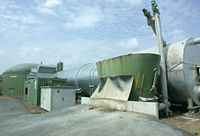
Photo from wikipedia
Removing pollutants and producing high value-added products are essential steps for sustainable disposal and utilization of biogas residues. Here, a coupled thermophilic composting and vermicomposting process was used to remove… Click to show full abstract
Removing pollutants and producing high value-added products are essential steps for sustainable disposal and utilization of biogas residues. Here, a coupled thermophilic composting and vermicomposting process was used to remove Cr from biogas residues, and the composting products were co-fermented with the plant growth-promoting fungus Trichoderma to produce high value-added biofertilizers. The results showed that thermophilic composting for 37 d markedly increased the total content of Cr but decreased the percentage of available Cr fractions. Synchrotron-radiation-based observations further provided direct evidence of the binding sites to support the results from traditional sequential extraction. At a density of 60 g earthworm/kg biogas residues, vermicomposting removed 23-31% of Cr from biogas residues. After vermicomposting, co-fermentation of biogas residues and Trichoderma was optimized, in which Trichoderma spores were 2-5 × 108 cfu/g substrates. Together, coupling thermophilic composting and vermicomposting processes is a promising technique to remove a portion of heavy metals from biogas residues.
Journal Title: Bioresource technology
Year Published: 2021
Link to full text (if available)
Share on Social Media: Sign Up to like & get
recommendations!